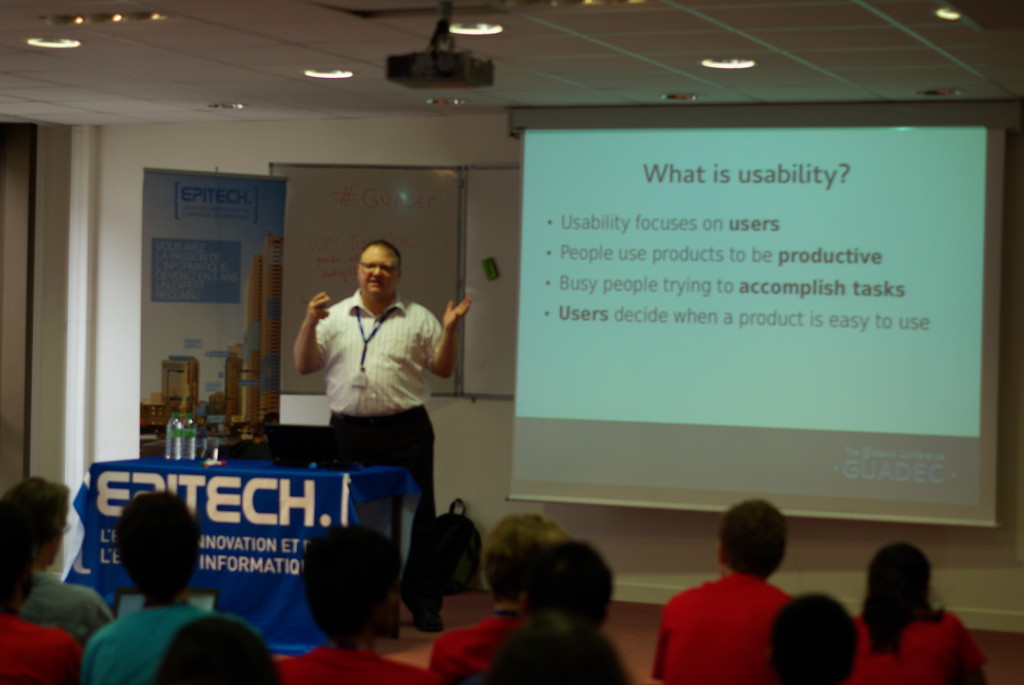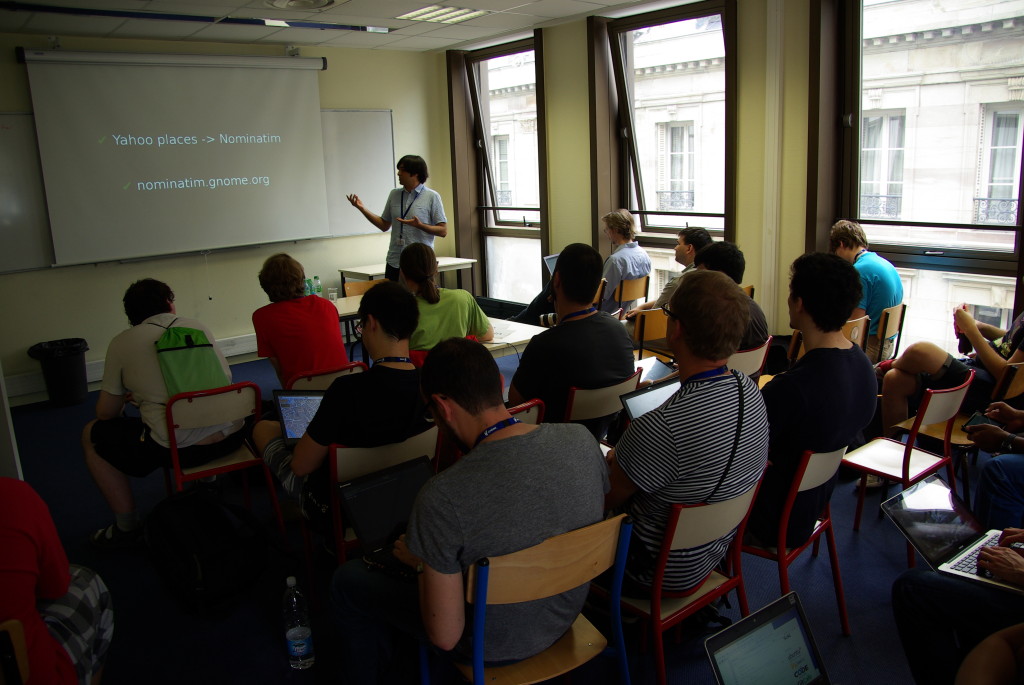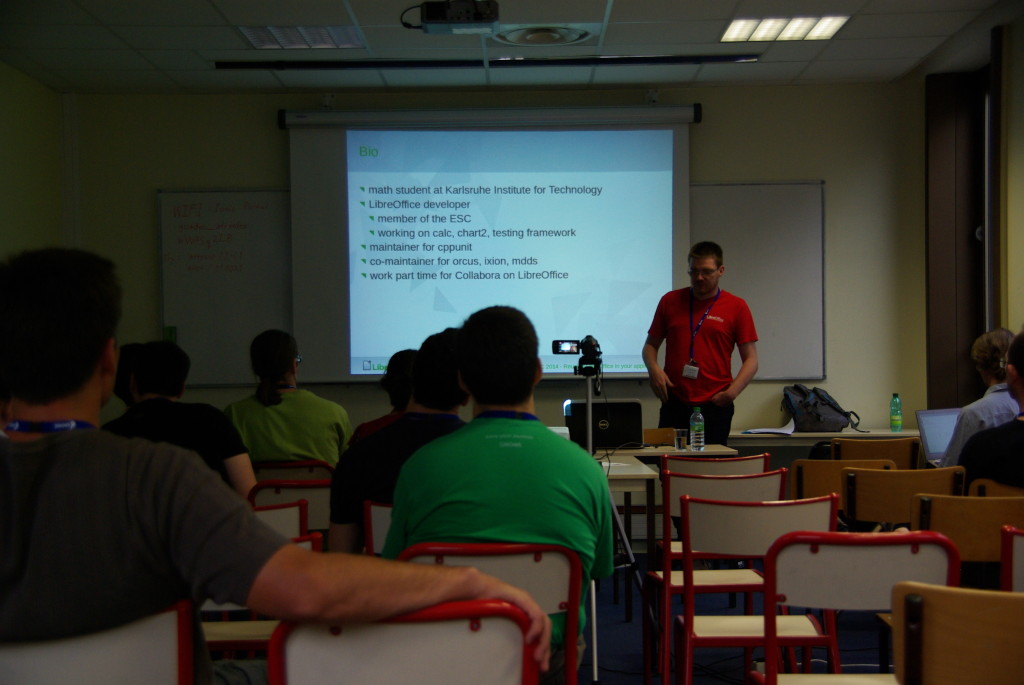GUADEC 2014 is taking place in Strasbourg. Because GNOME has been the default desktop environment in Fedora from the very beginning, and is going to be the environment for Fedora Workstation, I’ve decided to cover GUADEC for Fedora Magazine.
I went to Strasbourg from Brno with other fellow redhatters. There are about 15 of us from Brno office or Red Hat. But the total number of redhatters is much higher and I also recognized other contributors to Fedora (Kalev Lember or Elad Alfassa). The conference started with a pre-registration party Friday evening, but it was more or less “grab your badge, have a few words with others and run to the city for dinner.”
The city itself is really beautiful with a lot of historical buildings and everything is in a walkable distance. The conference is hosted in EPITECH. The venue is not ideal. The organizers had been planning to organize GUADEC at a different venue, but they had to change plans five weeks before the conference and were lucky to find this one. It has an advantage that it’s in the very heart of the city, just 300m from the cathedral.
GUADEC is a quite relaxed conference. There are just two tracks and only nine talks on the first day. In my opinion the most interesting talk of the first day was a keynote by Jim Hall on usability testing of GNOME apps.
Jim is a director of IT at University of Minnesota and he conducted a set of usability tests with users picks from university students and staff. For us, it’s definitely interesting that they used Fedora. All users had at least some experience with computers, none of them was an expert and ever used GNOME before. The tested apps were gedit, Web (Epiphany), Nautilus, Software, Notes. They gave us several pieces of advice for conducting usability testing: use plain language, don’t lead the tester, focus on tasks, limit to an hour.
The results were quite interesting. No one had a problem with Web. Most users couldn’t discover the app menu, but once they did they kept using it. That’s something I’ve also observed with users who used GNOME for the first time. No one really thought there could be some functionality hidden under the app icon and name on the top panel. A lot of users had problems to create a bookmark in Nautilus. They dragged a folder to the desktop and were surprised nothing had happened because desktop system they were familiar with (Windows, OS X) support icons on the destkop.
Users achieved very different results when installing the Robots game in Software. Those who used searching found and installed the app right away. Those who started browsing categories mostly failed. They found the app, but then they clicked “Website” button because that’s where they’re used to find installation files for the systems they are familiar with. Those who used searching were provided with the “Install” button right away, so they didn’t even have to go to the app’s profile to install it. So they didn’t even see the “Website” button. If you can more about Jim’s usability testing on his blog.
After the lunch, I went to the talk of Zeeshan Ali who spoke about geolocation in GNOME. Geoclue API helps apps and services determine the current location and set themselves accordingly. It’s now used in timezone settings, WebKit, Evolution, Clock, and Weather. Geoclue is using Yahoo Places and the Geoclue devs have created a proxy not to exceed the allowed number of queries. The API has become much richer in the last year. There are more sources (ModemManager for 3G and Mozilla Location Service for WiFi).
According to Zeeshan, there are still privacy concerns related to geolocation. The way it works via DBus one can’t reliably control what apps access the API. It will hopefully improve after implementing Kdbus. Zeeshan also spoke about new features in GNOME Maps. They should have better place search results and support route searches (walking, bicycle, car). He also made a live demo that showed that not everything works perfectly. The first result for searching airport from the location of Strasbourg was Hong Kong Airport 🙂 Planned features for Maps are support for points of interest, Foursquare and Facebook checkins and using public transportation in route searching.
The last talk I was attended on the first day was “Reusing LibreOffice in your application” by Markus Hornharn. He spoke about liblibreoffice which exposes most used features of LibreOffice to other applications through a simple API. It has C, C++ and Java bindings and currently implemented features in the stable branch are export and import. They are working on other, for example tiled rendering for devices with a small screen. Liblibreoffice will most likely be used by GNOME Documents which currently shows documents by exporting them to PDF which is far from ideal.
He also mentioned The Document Liberation Project whose goal is to share libraries and tools for document handling with other projects (already involved projects: Abiword, Scribus, Inkscape). The last part of the talk was devoted to better integration of Libreoffice with GNOME such as more native dialogs or supporting the app menu. A lot of has already been done, but a lot is yet to be finished.
In the afternoon, there was a workshop led by Marina Zhurakhinskaya for those who wanted to start contributing to GNOME. Participants could learn to use IRC, git, Bugzilla, diff, patch, JHBuild and get familiar with GNOME Dev documentation. Marina will lead the same workshop at Flock. So if you’re interested come to Flock 2014 in Prague!
The first day of GUADEC ended with team reports when various team in GNOME presented what had happened in their field of expertise in the last year.








liam
The appmenu is one of the ux decisions which seemed to have the most shaky justifications (besides practical difficulties of non-gnome apps continuing to use the more traditional menu system). It’s good this testing data was released, however. We need more ux testing in gnome and a willingness to backtrack from decisions shown to be problematic.
The liblibreoffice library sounds like it could become fantastic. With luck the document liberating folks will be able to get koffice/calligra on board as caligra seems to be having issues with doc further bring up that LO/OO have long supported. Being able to concentrate efforts on a single library will be hugely beneficial.
Thanks for the update.
Sudhir Khanger
@liam Appmenu is one of those things that are unnecessary fixing things that are not broken. proprietary, open source, kde, unity and other desktop developers are not going to change. In the end thanks to Gnome we have fractured stack of desktop applications all using different UI.
Paul Carroty
Videos?
Jiri Eischmann
All talks are recorded and I suppose the recordings will be available in a couple of weeks.
UR Mehta
Gnome is my preferred Desktop. It’s the reason why I switched to linux full-time.
Thanks for the coverage of GUADEC.